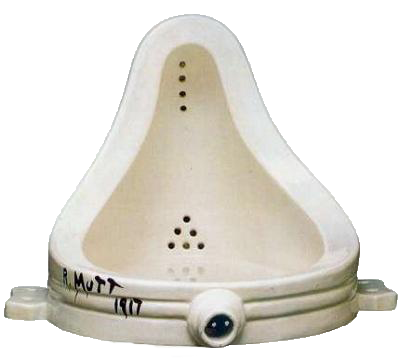HOME
HACKING & RETHINKING THE OBJECT
My previous entry inspired me to think about the concept of hacking, and the potential rethinking of what we deem physical. We live in a new world of materialities and objectivities, with post-structuralism destroying everything solid and replacing it with air. Perhaps it is time to notice once again the immediacy of the objects we live, work and converse with.
Some argue that the object is having a revival with the post-digital realm bringing the tangible object once again in to the foreground. With the interest in the object going back a long way, Marcel Duchamp’s famous work ‘Fountain’ still feels like the most explicit example of reimagining the purpose, thought or function of an object.
Meraud suggests that ‘intimacy organises our experience of space and especially of surfaces’ [Meraud 2015] thus complicating our relationship with objects in the modern day; social and material relations are entangled and distinguishing the software from the hardware in our everyday life becomes increasingly difficult. For example, the interaction with self-service machines at the supermarket or the reconstructing of our bodies with the help of prosthetic or genomic technologies is to blur the distinction between human and machine; this is equally fascinating as it is disconcerting bringing up all sorts of questions surrounding ethical and contradictory dilemmas. ‘What is an object’ seems an appropriate question here. The world of things have extended far beyond the idea of raw, tangible matter and actual existing realities into something far more abstract and imaginary. The internet is a perfect example of this: physically, does the internet exist?
Whilst much discussion of the virtual and the real holds them in opposition to each other, I am inclined to think that this distinction is blurred, particularly when we align the virtual with the idea of imagination and fantasy, and the real with body and flesh.
Perhaps virtuality instead shakes the firmness of reality.
It appears that as a society, we have come to appreciate the fluidity and instability of ontological boundaries when separating things from non-things.
Thought: Maybe I can approach the writing of music in this way when it comes to the development of my final piece; Re-contextualising what music means or is, and how it is made, a similar approach to the one I adopted when making the contact mic recordings.
With the concept of the making or altering of meaning in mind, I collaborated and experimented with a friend on a short film and ongoing project ‘Stuff Sanctuary’. We asked another friend to hand us an object (the necklace) without much thought, and this became our stimulus. Our intentions were to only consider the materiality of the object, ignore its function and imagine if it were to speak, what it would say.

[Duchamp's 'Fountain']
[CLICK ME]
Meraud’s discussion of iridescence as a ‘visual phenomenon’ was interesting to me, so I explored its definition some more. The idea of the necklace changing colour dependent on the viewing angle felt like an interesting place to start, and so I wrote this poem as a response:
Visible in.
Visible out.
Devise, refine, alter this suspended play of light.
Undress the gaze - slowly - and occupy a quivering space.
I am conscious - like pollen on bright air.
I am conscious - I seek to dazzle in black and white
I am conscious - 23 intrusive grains of sand
I am conscious - a cinder locks eyes with me and I am devoured.
I really enjoy the idea of hacking, and something about rethinking or re-imagining says something about our time. This feels like an invasive act which I think mirrors the impact of technology on societies experience of physical space, ourselves and those around us.
[CLICK ME]